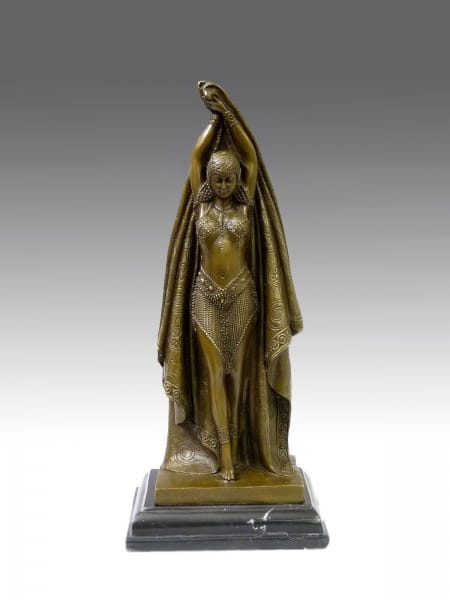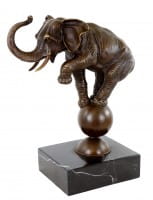Prices incl. VAT, free shipping worldwide
Ready to ship today,
Delivery time appr. 3-6 workdays










Product description
"Antinea - Demetre Chiparus Sculptures"
| Height | 35 cm |
| Width | 15,5 cm |
| Length | 12 cm |
| Weight | 3,8 kg |
Enchanting Art Deco Beauty – Antinea - Signed Demétre Chiparus
The Art Deco Bronze Dancer Statue – Antinea is a breathtaking Dancing Girl Statue that captures the mystery and glamour of a bygone era. The figure stands tall with arms raised gracefully above her head, her finely modeled body framed by a flowing, ornamented cloak. Every curve of the bronze surface reflects the soft glow of stage light, while the beaded costume shimmers with the suggestion of movement. This poised Dancing Statue seems to pause at the height of a performance, inviting the viewer into the luxurious world of Parisian dance. With its harmonious proportions and subtle detailing, the sculpture embodies the very essence of Art Deco sophistication.
Creation and Inspiration of Antinea
Demétre Chiparus conceived Antinea in Paris during the late 1920s, when the Art Deco style was at its zenith. This mesmerizing Dancing Sculpture bears the signature “D. H. Chiparus,” ensuring authenticity and connection to the master. Inspired by the fascination with Orientalist themes and theatrical dance, the work celebrates the elegance of exotic performance art that captivated European audiences of the time. The original Chiparus Bronze was cast using the lost-wax cire-perdue method, allowing every intricate bead and patterned fold of the cloak to emerge with crisp precision. Many of the finest Demetre Chiparus Sculptures combined bronze with carved ivory for the face and hands, a delicate contrast that brought the dancer to life.
Early Life and Artistic Formation
Demétre Haralamb Chiparus, born on 16 September 1886 in Dorohoi, Romania, grew up in a cultured family that encouraged his artistic ambitions and nurtured his fascination with the human form. After early studies in Italy, where the grandeur of Renaissance sculpture shaped his sense of proportion and movement, he moved to Paris to refine his skills. At the prestigious École nationale supérieure des beaux-arts he mastered classical techniques while embracing the vibrant modernism of the early twentieth century. This fusion of academic precision and avant-garde vision became the hallmark of authentic Demetre Chiparus Sculptures, visible in the expressive yet meticulously detailed lines of each Dancing Girl Statue. By the time he created the elegant Chiparus Bronze Antinea, his artistry reflected both his Romanian heritage and the cosmopolitan energy of Paris. Through this training and experience, Chiparus developed the unique style that made every Dancing Sculpture a lasting symbol of Art Deco sophistication.
Paris and the Art Deco Stage
In the vibrant Paris of the 1920s, music halls, cabarets, and the daring performances of the Ballets Russes shaped a new aesthetic of luxury and movement. Chiparus absorbed this energy, translating the rhythms of dance and the brilliance of stage costumes into timeless bronze. The exotic costume of Antinea, with its ornate patterns and jewel-like accents, reflects the fascination with faraway cultures that defined the Art Deco imagination. Collectors of the period were eager to acquire Chiparus Figures for Sale, recognizing in them a perfect balance of modern design and timeless grace. This Dancing Sculpture remains a vivid testament to that dazzling cultural moment.
Mastery of the Chiparus Bronze Technique
Creating a true Chiparus Bronze required extraordinary technical skill. Using the traditional lost-wax cire-perdue process, artisans captured every minute fold of fabric and each delicate bead of the dancer’s attire. Chiparus often heightened realism by combining bronze with finely carved ivory for the face and hands, bringing warmth and subtle expression to his figures. Such craftsmanship made his works enduring treasures for collectors and museums alike. Today, authentic Demetre Chiparus Sculptures such as Antinea can be admired in institutions including the Musée d’Orsay in Paris, the Victoria and Albert Museum in London, and the Metropolitan Museum of Art in New York, as well as in prestigious private collections around the globe.
Legacy of a Master Sculptor
Demétre Chiparus remained in Paris for the rest of his life, working steadily even through turbulent political times. He passed away on 22 January 1947, leaving behind a body of work that continues to define the golden age of Art Deco sculpture. Each Dancing Girl Statue he created transforms the fleeting grace of performance into a permanent celebration of movement. Collectors still seek original Chiparus Figures for Sale, drawn to their rare combination of sensual elegance and technical perfection. The Antinea Dancing Statue endures as one of the most captivating examples of his genius, ensuring that the allure of Demetre Chiparus Sculptures remains undimmed for generations to come.
Our advantages
free shipping
Worldwide free shipping
14 days money back
You can cancel your order
within 14 days
secure payment services
Paypal, Master Card, Visa, American Express and more






















































